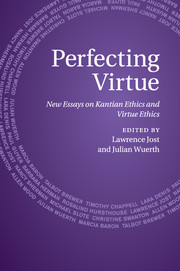Book contents
- Frontmatter
- Contents
- Notes on contributors
- Acknowledgements
- List of abbreviations
- Introduction
- 1 Virtue ethics in relation to Kantian ethics: an opinionated overview and commentary
- 2 What does the Aristotelian phronimos know?
- 3 Kant and agent-oriented ethics
- 4 The difference that ends make
- 5 Two pictures of practical thinking
- 6 Moving beyond Kant's account of agency in the Grounding
- 7 A Kantian conception of human flourishing
- 8 Kantian perfectionism
- 9 Aristotle, the Stoics, and Kant on anger
- 10 Kant's impartial virtues of love
- 11 The problem we all have with deontology
- 12 Intuition, system, and the “paradox” of deontology
- Bibliography
- Index
5 - Two pictures of practical thinking
Published online by Cambridge University Press: 04 February 2011
- Frontmatter
- Contents
- Notes on contributors
- Acknowledgements
- List of abbreviations
- Introduction
- 1 Virtue ethics in relation to Kantian ethics: an opinionated overview and commentary
- 2 What does the Aristotelian phronimos know?
- 3 Kant and agent-oriented ethics
- 4 The difference that ends make
- 5 Two pictures of practical thinking
- 6 Moving beyond Kant's account of agency in the Grounding
- 7 A Kantian conception of human flourishing
- 8 Kantian perfectionism
- 9 Aristotle, the Stoics, and Kant on anger
- 10 Kant's impartial virtues of love
- 11 The problem we all have with deontology
- 12 Intuition, system, and the “paradox” of deontology
- Bibliography
- Index
Summary
INTRODUCTION
In her influential attack on “modern moral philosophy” Elizabeth Anscombe writes, “If someone professes to be expounding Aristotle and talks in a modern fashion about ‘moral’ such-and-such he must be very imperceptive if he does not constantly feel like someone whose jaws have somehow got out of alignment: the teeth don't come together in a proper bite.” One of the principal sources of the sense of misalignment that Anscombe so vividly describes is that Aristotelian ethics is keyed to a conception of the nature and proper tasks of practical thinking that differs strikingly from the conception that frames Kantianism and most other positions in modern philosophical ethics. On the Aristotelian view, the most ethically valuable sort of practical thinking is a continuous activity that accompanies and completes those activities it guides and that forms an essential constituent of those activities. Modern theorists, by contrast, tend to picture practical thinking as a discrete and occasional process that precedes and initiates action. We can neither arrive at a full appreciation of the ethical thought of the ancients, nor offer a complete account of ethical excellence in practical thought, unless we begin by retrieving the unfamiliar conception of practical thinking that frames Aristotle's inquiry into ethics. This essay is intended as a sketch of some of the main contours and consequences of this project of conceptual retrieval.
Keywords
- Type
- Chapter
- Information
- Perfecting VirtueNew Essays on Kantian Ethics and Virtue Ethics, pp. 116 - 146Publisher: Cambridge University PressPrint publication year: 2011
- 2
- Cited by



